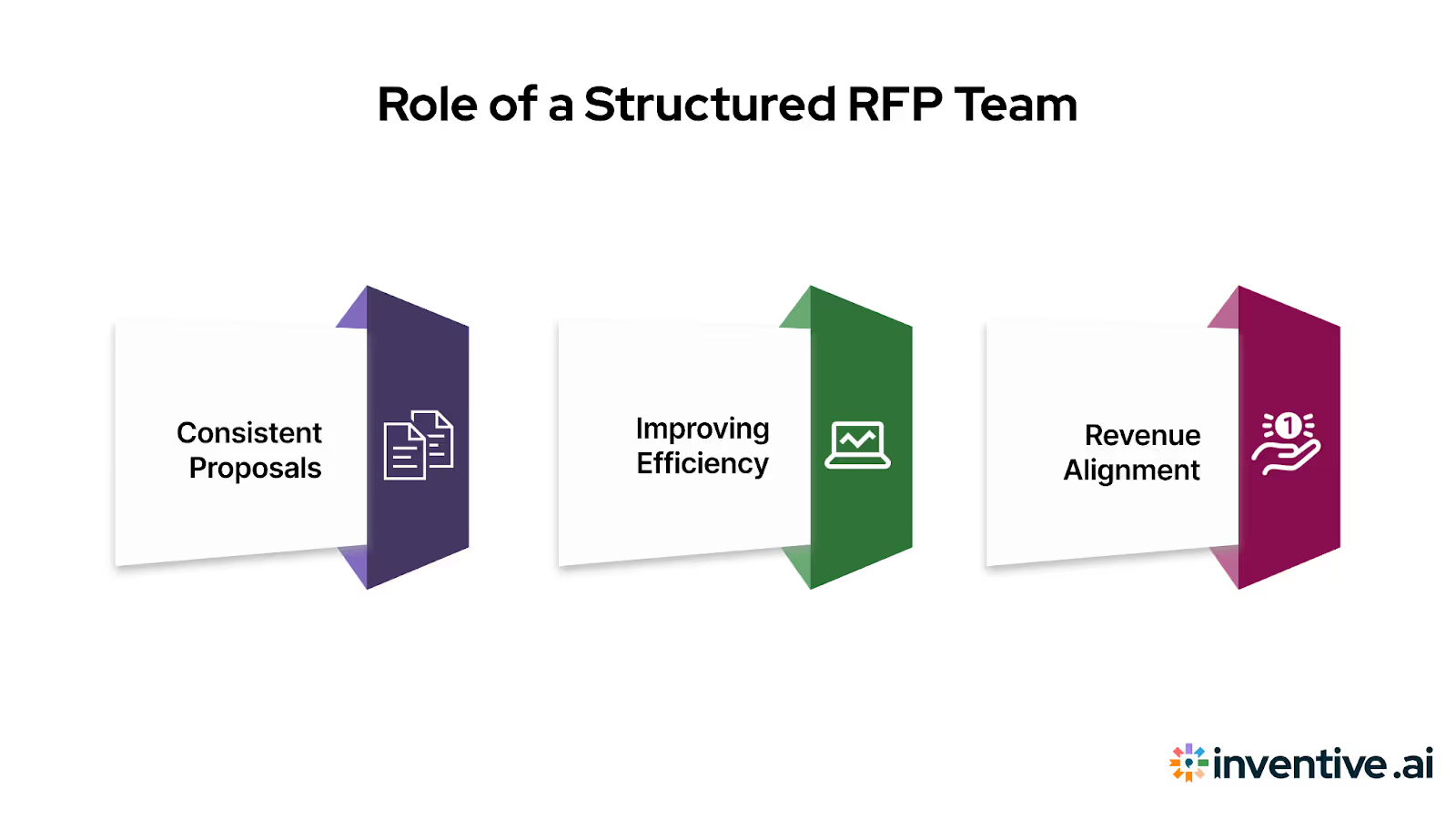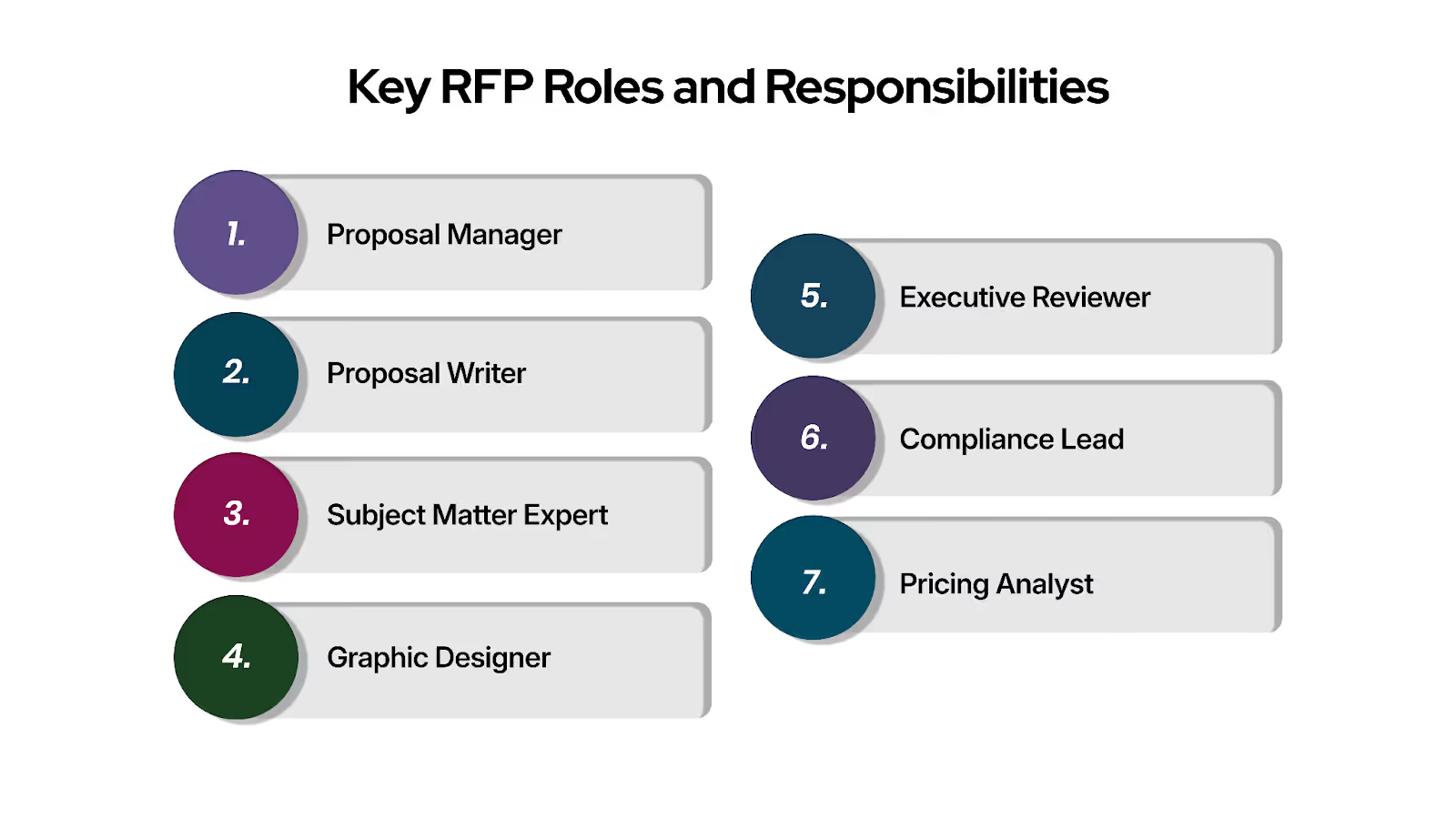Effective RFP Response Team Roles and Responsibilities
Responding to an RFP isn’t a solo job, and it’s not just a team effort, either. It requires writers, reviewers, SMEs, compliance leads, pricing analysts, and project owners, all working on tight deadlines and wearing different hats.

Glossary of Key Terms
- SME (Subject Matter Expert): An individual with deep knowledge and hands-on experience in a specific domain who contributes technical or specialized input to RFP responses.
- Capture Manager: A strategic role in the pre-sales or business development process, responsible for qualifying opportunities, crafting win strategies, and coordinating key inputs before the proposal is written.
- Content Reuse: The process of repurposing pre-approved content (such as bios, case studies, methodology statements, and standard answers) from previous proposals to accelerate response time and ensure consistency.
- Go/No-Go Strategy: A structured decision-making process used to determine whether an RFP opportunity is worth pursuing based on win potential, fit, and resource investment.
- BANT: A sales qualification framework that evaluates Budget, Authority, Need, and Timing to assess deal viability.
- Proposal Library / Knowledge Base: A centralized repository of reusable content, templates, and reference materials that proposal teams can access to streamline RFP response workflows.
Introduction
Responding to an RFP isn’t a solo job, and it’s not just a team effort, either. It requires writers, reviewers, SMEs, compliance leads, pricing analysts, and project owners, all working on tight deadlines and wearing different hats. But having a team isn’t enough.
To win consistently, that team needs to be structured, aligned to defined roles, and supported by tools that remove guesswork from the process. Companies that prioritize team building report a 23% increase in team performance. Cohesive teams work more efficiently and effectively towards shared goals.
In this guide, you’ll learn how to build and manage an RFP team that performs, covering role definitions, workflow ownership, performance tracking, and automation that supports real output.
What Is an RFP Team?
An RFP team is a cross-functional group responsible for drafting, reviewing, and submitting responses to Requests for Proposals. This team typically includes contributors from sales, operations, marketing, finance, and legal, each playing a critical role in assembling an accurate, compliant, and persuasive proposal.
Rather than a static department, the RFP team is often a dynamic unit that forms around opportunities. Depending on the complexity and timeline of the bid, it may be led by a proposal manager and supported by subject matter experts, writers, and reviewers.
A structured RFP team transforms a reactive process into a repeatable engine for growth.
Importance of a Structured RFP Team

An efficient RFP team brings significant advantages to any organization. Beyond a coordination role, this team directly influences how effectively your company competes for new business.
Enhancing proposal quality and response consistency
Defined ownership across sections ensures that responses follow consistent tone, formatting, and messaging. Each contributor knows what to deliver, when to deliver it, and how it fits into the overall response.
By working from standard templates and a shared content library, the team minimizes guesswork and enforces consistency from start to finish.
Increasing team efficiency and reducing errors
Role clarity reduces internal friction. Writers focus on writing, SMEs on expertise, and reviewers on approval. As each function works in parallel on assigned components, proposal timelines shrink without sacrificing quality.
Aligning proposal activities with revenue objectives
When sales, marketing, and proposal functions align, RFP responses do more than check compliance. They position your offer to win. Structuring the team around buyer needs ensures that messaging supports your revenue strategy.
So, how do you build an effective RFP team? It depends on a few core elements in your organization.
How to Build and Structure an RFP Team?
Before you assign roles, you need to understand when and how to form the right team. The size, scope, and frequency of your RFPs should guide this structure. As your pipeline matures, a formalized team moves from being a nice-to-have to a necessity.
Identifying when to establish a team
If you're handling 10+ RFPs monthly, pursuing high-value bids, or struggling with ad hoc coordination, it’s time to formalize your team. Structured teams reduce response time and increase win probability for complex, recurring bids.
Assigning roles and responsibilities
An effective RFP team typically consists of several core roles working together. At minimum, you need a Proposal Manager to oversee the process, a dedicated Proposal Writer to craft responses, and a group of Subject Matter Experts (SMEs) who rotate based on the technical questions. Depending on the complexity and size of the bid, you may also add specialized roles such as a Graphic Designer to handle visuals and a Compliance Lead to ensure all requirements are met.
For larger or more complex proposals, it’s common to include a Capture Manager who focuses on opportunity strategy and a Pricing Analyst responsible for developing competitive cost models. The total team size can range from 4 to 10 members, scaling with the project scope and deadlines. Smaller teams often combine multiple roles per person, while larger bids require dedicated specialists to handle the workload efficiently.
Integrating existing resources
Map current contributors to formal roles. A sales rep writing key answers might shift into an SME role. An operations manager manually chasing input can transition to a Proposal Coordinator with access to the proper tools.
With the team structure in place, the next step is to clearly define each role’s responsibilities. Understanding who does what ensures accountability and keeps the response process on track.
Core RFP Roles and Their Responsibilities

Each role in the response process solves a specific problem, from managing timelines to translating technical details into client-facing value. This section outlines the core team structure, defines what each role does, and explains why it matters in a high-stakes bid environment.
1. Proposal Manager
The Proposal Manager is the operational lead of the RFP process, responsible for coordinating people, deadlines, and deliverables across the team.
Key Tasks:
- Build and manage the response timeline
- Assign task ownership and track delivery
- Lead kickoff and status meetings
- Ensure the final submission meets all requirements
Without centralized coordination, proposals become disorganized and late. The Proposal Manager ensures deadlines are met, roles are clear, and the team stays aligned from start to finish.
2. Proposal Writer
The Proposal Writer is responsible for turning technical input into persuasive, reader-friendly proposal content that meets the buyer’s evaluation criteria.
Key Tasks:
- Draft and revise narrative content
- Apply structure based on the RFP’s layout
- Incorporate SME input while maintaining clarity and tone
- Enforce voice consistency and grammar standards
The writer controls how the company is represented on paper. Strong writing improves clarity, increases readability, and can directly influence evaluator scoring.
3. Subject Matter Expert (SME)
The SME provides technical or operational expertise that ensures the proposal content is accurate, credible, and context-specific.
Key Tasks:
- Answer domain-specific questions from the RFP
- Supply case studies, methods, or metrics
- Validate final content for accuracy and completeness
Proposals without SME input risk sounding vague or incorrect. SMEs provide the depth that evaluators look for when assessing technical competency.
4. Graphic Designer
The Graphic Designer develops branded visuals that make proposals easier to navigate and more compelling to review.
Key Tasks:
- Design layouts, infographics, and visuals
- Format tables, timelines, and profiles
- Ensure consistency with brand and RFP instructions
Visual design helps evaluators process information quickly. Good design improves comprehension, builds trust, and differentiates the response from competitors.
5. Executive Reviewer
The Executive Reviewer acts as the final approver who evaluates the proposal from a business and reputational lens.
Key Tasks:
- Review for tone, strategy, and risk
- Confirm alignment with corporate goals
- Approve the final proposal for submission
This role ensures that the response doesn’t conflict with internal commitments or overpromise. Their approval protects long-term interests and brand reputation.
6. Compliance Lead
The Compliance Lead ensures the proposal meets every stated requirement structurally, legally, and procedurally.
Key Tasks:
- Check for mandatory content and certifications
- Enforce page limits, formatting, and document structure
- Flag noncompliance issues before submission
Many strong proposals fail due to technical disqualification. The Compliance Lead prevents avoidable rejections by keeping everything within scope and rules.
7. Pricing Analyst
The Pricing Analyst develops the cost structure that balances competitiveness with internal profitability.
Key Tasks:
- Build detailed pricing sheets and models
- Align with finance and sales on margins
- Clarify assumptions used in the cost breakdown
Pricing is often a decisive factor. A well-reasoned price strategy can win competitive bids without undercutting the business.
Key RFP Team Roles and Responsibilities
Also Read: RFP Response Best Practices: Proven Steps and Tips to Win More
Overcoming Challenges in RFP Responses
RFP responses are complex projects prone to common obstacles that slow teams down or compromise quality. Understanding these challenges helps teams put safeguards in place and maintain momentum.
- Fragmented Communication: Dispersed stakeholders and unclear ownership lead to missed messages and duplicated work. Establishing centralized communication channels and clear points of contact ensures faster decisions and fewer errors.
- Last-Minute Content Gaps: Waiting too long to gather SME input or pricing details creates bottlenecks. Early planning and defined deadlines for each contributor help avoid crunch-time firefighting.
- Version Control Confusion: Multiple document versions floating across emails and drives cause inconsistencies and errors. Using centralized, version-controlled platforms keeps everyone working on the latest draft.
- Overlapping Roles and Responsibilities: When team members are unsure who owns what, critical tasks slip through the cracks. Clear role definitions and documented responsibilities prevent duplication and omissions.
- Compliance Risks: Missing mandatory forms, certifications, or formatting requirements leads to disqualification. Compliance checks are integrated throughout the process catch errors before submission.
- Pressure-Induced Errors: Tight deadlines increase stress and mistakes. Realistic timelines, contingency plans, and leveraging automation tools reduce last-minute rushes.
- Inadequate Content Reuse: Recreating responses from scratch wastes time and undermines consistency. Maintaining a content library with reusable, updated answers accelerates drafting and improves quality.
Proactively addressing these challenges transforms RFP responses from frantic scrambles into coordinated efforts, increasing your chances of winning.
Tools and Software for RFP Teams
Coordinating an RFP response manually means managing dozens of moving parts across multiple people, versions, and deadlines.
Proposal managers chase updates. Writers patch together fragments from old bids. SMEs reply in email threads with outdated files. Reviews overlap, timelines slip, and the final submission often comes down to last-minute fixes.
To handle this complexity, dedicated software exists to manage the RFP response process from intake to submission. These tools are built specifically to support the way cross-functional teams work, centralizing content, tasks, approvals, and version control in one place. In fact, More than 90% of workers recently surveyed said automation solutions increased their productivity, and 85% said these tools boosted collaboration across their teams.
Most modern RFP platforms offer advanced capabilities designed to reduce friction across the team:
- Automated task assignment and deadline tracking
- Role-based access to ensure secure collaboration
- Content libraries for faster reuse and version control
- Real-time comments and status updates for review cycles
- Integration with CRMs, document storage, and email tools
AI-driven platforms take this further by assisting with content suggestions, flagging outdated language, and learning from past wins. Instead of starting from a blank document or searching for examples, teams can respond using tailored, data-backed inputs that align with client needs.
Inventive AI powers faster, more accurate RFP responses. Inventive AI’s AI powered RFP response software is built to help proposal teams eliminate manual work and submit with confidence. With features like near-zero hallucination, context-aware answers, and centralized knowledge updates, your team stays focused on getting the response right, without losing time to process errors or version issues.
Also Related: 5 Ways AI Will Transform Proposal Management in 2025
Performance Metrics for RFP Team Success
If you don’t measure it, you can’t improve it. Tracking RFP metrics gives teams visibility into what’s working, where delays happen, and how to increase win rates over time. Below are the key indicators that reflect performance at both the team and process levels.
- Win Rate: The percentage of submitted proposals that result in a win. This is the most direct indicator of output quality and alignment with opportunities worth pursuing.
- Response Time: Average number of days from RFP receipt to submission. Shorter cycles mean better internal coordination and stronger prebuilt content.
- Content Reuse Ratio: How much of the response was pulled from a content library or past proposals vs. newly created? Higher reuse reduces drafting time and increases consistency.
- SME Response Time: Time taken by subject matter experts to deliver inputs after being assigned. Delays here often stall the writing and review phases.
- Review Cycle Count: How many rounds of edits does the proposal go through before final approval? Fewer cycles suggest better upfront planning and role clarity.
- Compliance Error Rate: The percentage of proposals flagged for formatting errors, missing attachments, or unmet RFP requirements. A low rate reflects strong process discipline.
Conclusion
Winning an RFP isn’t just about having the right answers—it’s about building a well-structured, high-performing RFP team. When each member owns their role and has the tools to collaborate efficiently, your proposals become sharper, faster, and more competitive.
A strong RFP team reduces confusion, accelerates timelines, and raises your win rate. With the right workflows and technology in place, your team can respond with confidence every time.
Want to see how Inventive AI supports every member of your RFP team? Book a demo today.


